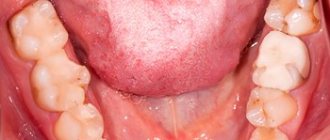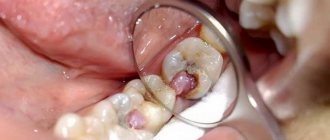Temporary fillings in dentistry are used for a variety of purposes, but mainly at intermediate stages of root canal treatment, as well as dental prosthetics.
In this article we will focus on root canal treatment and the use of temporary fillings with all known arsenic.
It is worth noting that the use of arsenic, as such, is becoming rare in modern dentistry. Since this material itself is extremely toxic and its improper use can cause great harm. Today, arsenic-free pastes that are used for the same purpose as arsenic are more relevant.
Is it possible to put arsenic in a tooth?
Arsenic is a chemical element that belongs to immunotoxic substances, that is, poisons.
It disrupts the exchange of selenium, sulfur and phosphorus in tissues, which leads to a lack of oxygen, hypoxia and, as a result, cell death. In dentistry, it is not pure arsenic that is used, but a paste with arsenous acid anhydride in combination with various anesthetic and antiseptic components. Below, by arsenic we will mean a paste, and not a pure chemical element.
The toxin was first used for dental treatment in 1836. Nowadays, treatment methods have changed significantly, but in some cases dentists still use acid.
In the article Stom-Firms.ru we will tell you why arsenic is placed in the tooth during treatment. We will describe how and for how long it is placed, and also list the complications that may arise.
When is a child's dental nerve removed?
The main indication for removing a nerve in a child’s tooth is pulpitis.
The disease is characterized by inflammation of the pulp, in the tissues of which there are vessels and the nerve itself. Pulpitis is accompanied by severe pain, deterioration of general condition and weakened immunity. There are risks of inflammation spreading and complications developing. Nerve inflammation is a complication of deep caries. Microbes that penetrate the dentin gradually infect the pulp, resulting in pulpitis. If treatment is not carried out in a timely manner, the pathological process begins to progress, gradually spreading to the soft tissues, and then to the jaw bone.
Removal of the nerve of baby teeth is not carried out only if the child has already begun the process of changing teeth, and a permanent tooth is growing in the coming months. An x-ray is taken to determine the prognosis. For such indications, tooth extraction is performed, since there is no risk of bite displacement.
Indications and contraindications for the use of arsenic
Arsenic acid is used for devitalization, that is, killing the dental pulp in order to then partially or completely remove it. Before the development of anesthesia, this was the only way in which it was possible to remove a tooth relatively painlessly, cure pulpitis and some other dental diseases.
Now the pulp is removed under local anesthesia and using drugs without arsenic. But there are indications according to which he is still placed. These include:
- Acute diffuse or chronic fibrous pulpitis;
- Chronic hypertrophic pulpitis in teeth with impassable and curved canals;
- Allergy to local anesthetics;
- Severe general condition, for example, after a heart attack or stroke;
- Inability to open the mouth wide due to contraction of the lower jaw.
Dentists emphasize that arsenic is not an alternative to pulp removal with anesthesia. The toxin is used as a last resort when the patient has indications for it.
Arsenic should not be placed in the dental cavity if:
- Allergies to paste components;
- Pregnancy and lactation;
- Increased eye pressure;
- Diseases of the urinary system;
- Unformed roots.
In pediatric dentistry, arsenic should not be administered to children under 1.5 years of age. But today, paste with arsenic acid is practically not used to treat pulpitis in a child. Pulp devitalization is carried out with other drugs.
How long can you walk with a temporary filling?
The material used for temporary filling is highly durable. The filling does not break down for a long time. The specialist determines the period of wearing temporary filling material based on the nature and degree of neglect of the disease. The duration of wearing the filling is individual for each patient.
At the end of the established period, the person must immediately contact a specialist. An increase in the time period can lead to the development of diseases. In some cases, the filling may crumble at the end of its period, and the drug will negatively affect the patient’s body.
How to put arsenic in a tooth
Depending on the age of the patient, the condition of the pulp and the size of the tooth, the doctor determines how much paste is needed. Typically, its amount varies from 0.0002 to 0.0004 mg.
Let us describe the stages of the procedure:
- The dentist uses an excavator to remove food debris, damaged tissue and thinned dentin from the carious cavity;
- A ball-shaped paste is placed on the pulp horn and covered with a bandage;
- Hermetically seals the cavity with a temporary filling.
Sometimes doctors put the paste on the unopened pulp. Then, after the procedure, the tooth may be very painful, especially when pressed, because swelling occurs and pressure in the tissues increases.
Usually, adults put arsenic in single-rooted teeth for 24 hours, in multi-rooted teeth for 2 days, but this period can increase to 6 days depending on the manufacturer and brand of the drug. Then the patient comes back for an appointment, and his pulpitis is treated in the traditional way: the temporary filling is removed, the cavity is prepared, the pulp is removed or amputated, the canals are processed and sealed.
Consequences of nerve removal
In the first 1–2 days after treatment, the tooth may hurt, but the intensity of the pain gradually decreases. To alleviate the condition, you can take analgesics recommended by a specialist. There are no other consequences of nerve removal.
Since pulpitis is most often caused by caries, during the treatment process the dentist removes the affected crown tissue. Restoring the integrity of the tooth is performed after removing the temporary filling. For correction, a filling material that does not contain toxic substances is used. In some cases, when the area of the carious cavity is too large and there is a risk of the filling falling out, it is recommended to install prostheses (stump or artificial crown.
Many parents mistakenly believe that depulpation implies the absence of a nerve in a permanent tooth. However, this is not at all true. Temporary and permanent teeth have separate systems and tissues that are not interconnected.
Martinka Children's and Adolescent Dentistry treats pulpitis by removing the nerve. Timely and correctly performed removal of the nerve of a baby tooth has no consequences. The integrity of the tooth is restored, and its functionality is preserved.
What to do if complications arise when using arsenic
If the doctor correctly selected the dosage and hermetically installed the temporary filling, and the patient came for a follow-up appointment on time, there will be no complications after using the paste. They occur if the therapist used too much of the substance, did not install the filling tightly and it fell out, or when the patient missed the deadline for taking it and walks with arsenic longer than expected.
The most common complications include:
- Burn of the mucous membrane, for example, gums;
- Necrosis of surrounding tissues and pulp of adjacent teeth;
- Arsenic periodontitis and periodontitis;
- Osteonecrosis is the destruction of jaw bone cells.
If arsenic falls out, the patient has a headache, feels sick and vomits, contact the clinic immediately. When the poison enters the body, the doctor administers an antidote. In case of damage to the mucous membrane, treat the affected area with antiseptics and drugs that block the spread of the toxin and accelerate tissue epithelization.
In modern dentistry, to avoid overdose, the paste is produced in special granules. The main thing that doctors urge is not to overexpose arsenic: keep it for as long as you are prescribed to walk with it. Then the risk of complications becomes minimal.
What can happen after installing a temporary filling?
In some cases, patients experience pain after placing temporary filling material into the tooth cavity. Mild pain during the first 5 days after the intervention is considered normal. If pain intensifies, you should immediately consult a doctor. Violation of this rule can lead to the development of various diseases and tooth loss.
It is normal to have a smell or taste of medication in the mouth after the procedure. The sudden appearance of a strong smell or taste of medicines indicates depressurization of the filling and leaching of medicines with saliva from the tooth cavity. Some drugs, if they enter the oral cavity, can have a negative effect on the human body. If such signs appear, you should immediately contact a specialist.
Swelling of the gums, darkening of tooth enamel, and the appearance of bad breath indicate the development of diseases. If symptoms appear, you should contact your dentist immediately. The doctor will remove the filling material and carry out diagnostic measures. You may need to contact your dentist if the filling breaks. Failure to visit a specialist in a timely manner will result in food particles and bacteria entering the tooth cavity.
More information on the topic
When they use arsenic and why, you will learn even more in the articles:
- Deep caries
- Treatment of periodontitis
- Dental prosthetics
References for the article:
- Kostina I.N., Nikolaeva A.A. “Arsenic necrosis of the jaw - complications in the treatment of dental pulpitis” // “Problems of Dentistry” No. 3, 2010.
- "Endodontics. Pulp diseases" // Textbook / A.S. Opravin et al. – Arkhangelsk: Publishing House of the Northern State Medical University, 2016.
Indications for using arsenic for a sore tooth
In most cases, the doctor turns to arsenic paste for help in the following situations:
- intolerance or allergy to anesthetic used in dentistry;
- poor tolerability of treatment even with the use of painkillers;
- urgent indications for the patient, most often when visiting the doctor on duty, when it is not possible to use a paid good pain reliever;
- lack of effect from the therapeutic dosage of the anesthetic, increasing its amount is dangerous, as it can provoke anaphylactic shock, in which case the paste will have the necessary effect;
- inability to use an anesthetic drug due to the patient’s medical history, usually with serious kidney and liver diseases;
- the patient’s fear of injections, usually in childhood or with excessive nervous excitement;
Arsenic is added when there is no effect from the therapeutic dosage of anesthetic
Attention! Before administering the medicine, you should make sure that the patient feels well. Sometimes poor condition, especially fever and nausea, can cause more severe intoxication of the body, since arsenic will only worsen the patient’s health.
How is arsenic used?
To kill a tooth, you will need to visit the dentist twice:
- The first time is to install the substance.
- The second is for removing it.
Installation
The procedure for your first visit is as follows:
- The doctor refers the patient to X-ray diagnostics of the diseased tooth. Having received the photo, he, focusing on it, will open the carious cavity. Then the inside of the tooth is cleaned of dead tissue.
- Then arsenic is placed on the site. A small cotton ball soaked in an anesthetic can be placed on top of it, which should relieve discomfort.
- The inside of the tooth is then sealed with a temporary filling to prevent dirt from getting in. The patient is released for 1.5-2 days. The doctor will tell you the exact number of days when scheduling the next visit.
Usually, the patient is advised to call if particularly severe pain occurs. If medications do not help and the condition worsens sharply, the doctor may advise you to go to the nearest dental department and remove the temporary filling, or do it yourself.
Arsenic installation process
Extraction
At the second appointment, the dentist removes the temporary filling. The cavity inside the tooth is carefully processed and then cleaned of arsenic residues. Then the doctor, having checked the sensitivity of the nerve, proceeds to remove it.
To make sure that the arsenic has been completely removed, a dye is added to the preparation before installing it, making the substance easy to see on the walls of the tooth.
Self extraction
If for any reason after applying the drug, prolonged pain appears, this means that the negative effect of arsenic has spread further to healthy tissues. In order not to delay removing the filling and paste, the patient can do it himself.
First, remove the filling itself: they are made of soft materials and are easily pryed off with a needle. The paste itself is also cleaned with a sharp, thin object (tweezers).
The main task is not to ingest arsenic during cleaning. Any instrument must first be disinfected, and then cover the open area with a cotton ball or swab.
Then the oral cavity should be rinsed with a solution of soda, iodine or hydrogen peroxide. Plus, you can rinse your mouth with milk - it also helps to neutralize any remaining substances. Afterwards, you should visit your doctor as soon as possible to avoid complications.
How can you get rid of arsenic without a doctor?
Doing such things is, of course, not recommended. But in situations where, for certain reasons, a trip to the doctor is postponed, you can remove the arsenic paste yourself. To do this, you need to thoroughly clean the oral cavity with a paste, use a balm rinse, and then a weak solution of potassium permanganate. Hands also need to be treated with any antiseptic.
After this, using a sterile needle, if you don’t have one, simply disinfect the sewing needle in a concentrated solution of potassium permanganate, iodine or alcohol, and carefully crumble the temporary filling. It is very soft, so it gives in easily. It is important not to touch the filling or go deeper into the pulp of the tooth. Arsenic is gray in color, it should be carefully picked up with a needle and pulled out, do not swallow it under any circumstances. After this, the oral cavity is again treated with an antiseptic, and the diseased tooth is filled with a sterile swab or cotton wool.
When there is really no way to contact even the doctor on duty, you can remove arsenic yourself
Attention! This should be done in exceptional cases, when there is really no way to even contact the doctor on duty. Independent manipulations can significantly complicate the patient’s condition.
Many doctors are already refusing arsenic paste, citing its danger to the body if accidentally ingested. Also, doctors are forced to take such measures by the patients themselves, who do not always come to the doctor on time after laying arsenic, which causes quite strong side effects and inflammatory processes. Dentists with extensive experience are sure that it is better to pay a little extra money for a modern anesthetic, they are produced in Germany, Japan and the USA, and immediately carry out all the necessary manipulations with a diseased tooth. This will significantly save time and reduce the risk to the patient’s health.
Harm of arsenic during dental treatment
Arsenic is a very strong toxin that should not be used thoughtlessly. When using the drug, there is a possibility of severe blackening of the tooth and swelling of the pulp, which only increases the pain. In addition, arsenic paste can cause drug-induced periodontitis, which is manifested by an inflammatory process in the periodontal tissues.
Taking into account such complications, the drug is used only in exceptional cases during pregnancy and up to 12 years, when the body is hypersensitive to any active substance. At the same time, it is quite difficult to calculate the dosage of the medication for patients in these groups, since the existing dose is designed exclusively for adult patients without serious pathologies in the body.
Swelling of the remote control is one of the possible complications of arsenic ingestion
Also, patients often complained of the following side effects; in some cases, symptomatic treatment was required:
| Sign | Frequency of occurrence |
| Pain in adjacent teeth and gums | Often |
| Headache | Often |
| Jaw pain | Often |
| Nausea | Rarely |
| Increased body temperature | Sometimes |
| Vomit | Often |
- Why is there arsenic in the tooth?
Attention! If arsenic is used excessively or if there is a strong sensitivity to it, the dangerous condition of osteonecrosis can develop. This is the name of the disease when the tissues of the periosteum and bone begin to die.











